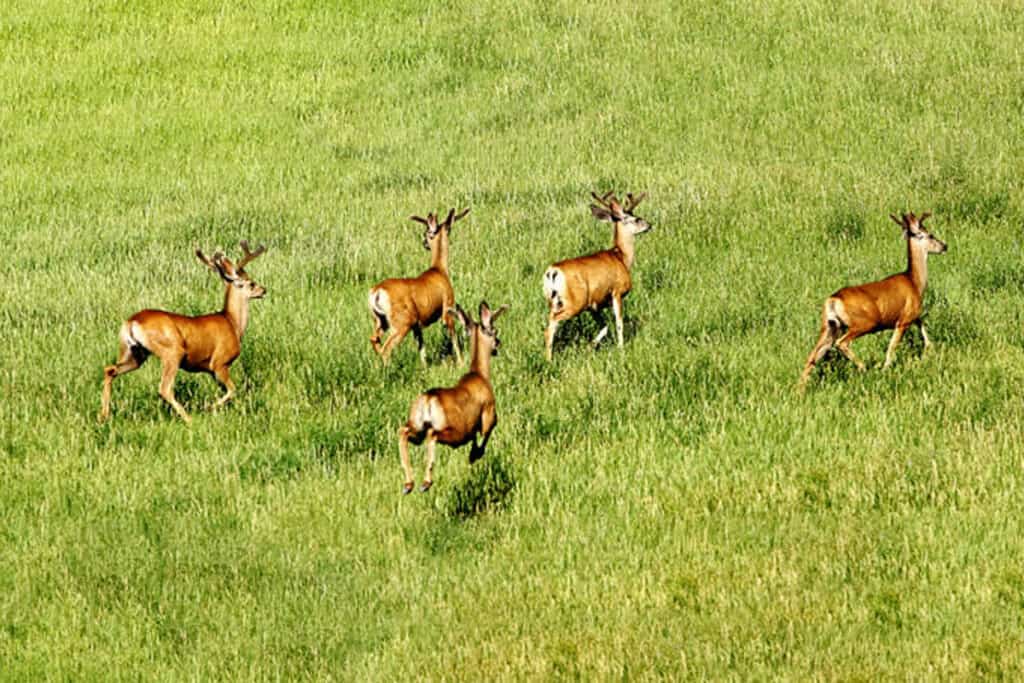COLORADO RANCH REAL ESTATE FISHING & HUNTING PROPERTIES
HUNTING and FISHING IN THE ROARING FORK VALLEY, CRYSTAL RIVER VALLEY, NORTH FORK VALLEY AND THE REST OF COLORADO—AN OUTFITTER’S GUIDE TO FINDING THE IDEAL HUNTING AND FISHING PROPERTIES

Big game hunting on the Western Slope of Colorado, surrounding the communities of Glenwood Springs, Carbondale, Aspen, Meeker, Paonia, Crawford, Hotchkiss, Somerset, and Cedaredge, is a favorite tradition for out-of-state visitors and locals alike.
For out-of-state hunters looking to find a hunting property with excellent opportunities for trophy mule deer and elk, the North Fork Valley is a great place to start your search, but there are good opportunities all over the state, ranging from Granby, where huge bull elk wander out of Rocky Mountain National Park, to Lake City and Powderhorn, where massive trophy bucks have been taken.
As a former wilderness outfitter, big game hunting guide, and fly-fishing guide, I have a good handle on what factors are important for a good hunting or fishing ranch. I’ll go down through my list with you, and if you’re interested in a ranch property, call me up and I’ll see if I can find a hunting property or fly-fishing retreat for you.
COLORADO HUNTING PROPERTIES–Deer, elk, bear, grouse, turkey, antelope
Here are the factors that you’ll be looking for in a recreational hunting property:
- Great habitat. Without the right combination of aspen groves, dark timber, oak brush, open meadows, running water, and good forage, a hunting property is missing a crucial aspect.
- Proximity to public lands. If you buy a 200-acre ranch, that might seem pretty small for a hunting property. However, if it offers exclusive access to 10 square miles of BLM or National Forest property, it suddenly becomes very large. Correspondingly, if a major access point for public land hunters is close by, you won’t reap as great a benefit from owning private property.
- Privacy. This goes hand in hand with the proximity to public lands. A quiet, remote spot on a little-used back road might be just perfect.
- Access. You have to be able to get to your mountain hunting property. There are terrific properties accessible by paved highways, and then there are hunting cabins and lodges that require major effort to get in and out if there’s a little weather.
- Proximity to the airport. It’s very convenient to be able to get in and out of town quickly—and a drag if you’re in for a major journey every time you come and go. It’s even better if you have your own airstrip! We know of properties for sale that have either airstrips on them or close by. Call us if you’re a private pilot seeking a mountain airstrip property for sale.
- Thriving game animal populations. Sure, you can hunt for five days straight and bag the only animal you see on the last day, but it’s a lot more fun to see a lot of animals and take a real trophy on the second day and then relax!
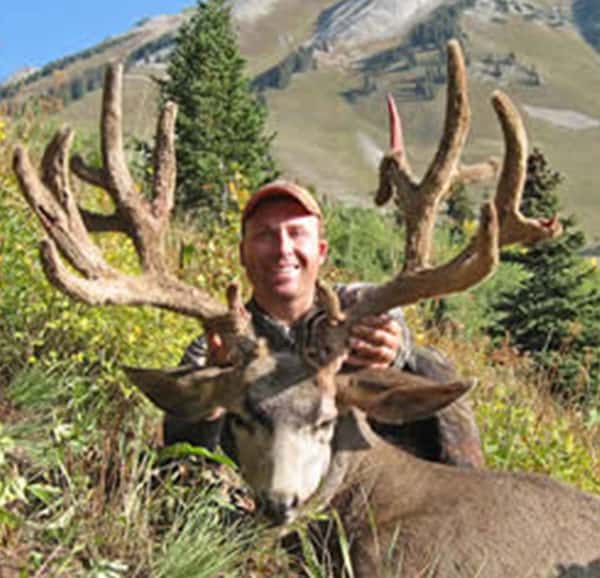
This buck was taken in the wilderness area between Aspen and Crested Butte. This trophy 9×7 mule deer scored 219.
7. Good facilities. You aren’t expecting the Ritz-Carlton, but who wants to live in a hovel? Nobody. If someone is representing a hunting property or a fishing lodge as a good value, then you need to be able to spend the night there in comfort. Satellite TV, electricity (or solar power or a generator), hot water, good construction, a decent kitchen—they all matter, as well as horse corrals, tack rooms, meat lockers, storage sheds, and barns.
8. Licenses. Can you get tags to hunt the land you’ve just bought? Believe it or not, this can be a big issue. Landowner vouchers, private land tags, lottery drawings for licenses—all these factors can be a make-or-break issue when buying a hunting property. If you can’t get a license to hunt the property you just bought, what good is it?
FISHING PROPERTIES
What about fishing? Many realtors will represent a piece of land with a trickle of a stream as a “great flyfishing property”. Heck, a realtor once showed me an eight-foot-wide sinkhole filled with gray water from the sink and washing machine and called it a “pond feature”. Most brokers don’t know a fly rod from a pushrod. I do. I guided fly-fishing for 22 years, and I’m the co-author of the award-winning book, “Shadowcasting: An Introduction to the Art of Flyfishing.” If it’s not a good fishing property, I’ll tell you just that.
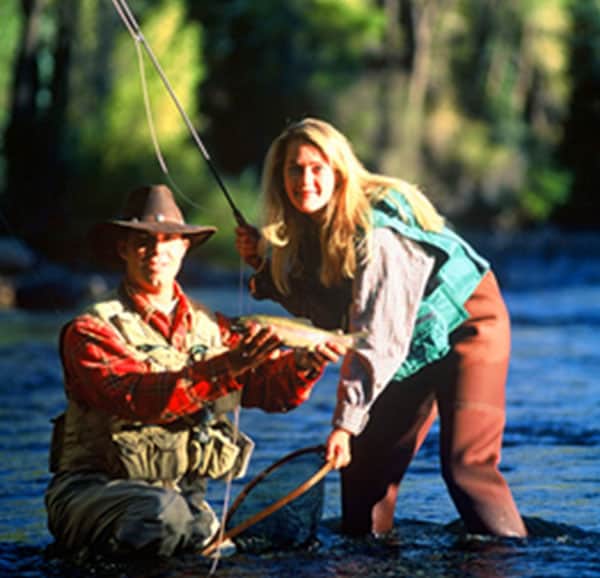
Here are factors to consider when purchasing a Colorado trout fishing property:
- Stream flows. You can have fun fishing in a stream flowing 20 cubic feet per second, but not if it dries up in late August. The stream must have consistent natural flows.
- Public and private access. You may not be aware of this, but Colorado law states that you can own the ground underneath a trout stream. It’s one of only two states with such stream-bottom property rights.
- Sediment load. Some streams run clear, and some run dirty. If you’re looking at a fishing property on a stream with unstable soils upstream, you could have unfishable conditions much more often. It’s simple geology.
- Insect populations. There are some streams that are alive with the insects that feed trout—mayflies, caddis, stoneflies, midges, craneflies, sow bugs—and that means healthy trout populations. Other streams don’t have nearly as many bugs, which could be due to mine runoff, shale formations, an overabundance of copper, or any number of factors.

A little privacy on your own river frontage property can leave you with priceless memories
- Stream frontage. On a quiet river with a lot of public access, 200 feet of stream frontage may be more than enough. On a crowded, popular river where other landowners jealously safeguard their access, it may not be nearly enough to have a good time fishing.
- Access to airports and town. The ladies will be a lot happier if you end up at a place where good restaurants, shopping, and some entertainment is within a reasonable distance.
- Improvements and amenities Water rights, horse pastures, spectacular views, ponds, luxurious housing, boathouses, guest cabins—these amenities are valuable to both you and the ranch owners. When someone has done the work for you and you like the improvements, you’ve just saved yourself a year or two of design, construction, clutter, and mess.
THE NORTH FORK VALLEY–Colorado Deer and Elk Game Management Units 52, 521, 53, and 63
The Colorado Division of Wildlife has marked out big game hunting units all across the state. Some units are managed more for quantity rather than quality, particularly for elk. Hunting licenses are allocated by drawing in quality management areas. All deer licenses statewide are issued by drawing only.
Game Management Unit 52 lies north of Highway 92 from Hotchkiss on the east end of the unit to the Highway 65 turnoff on the west end. The hunting region extends north all the way to the middle part of the Grand Mesa. This area is mostly south-facing and warm, and when the snow flies, the deer and elk migrate down to ranches that offer outstanding hunting.
Game Management Unit 521 is a large unit north of Paonia that extends clear up Muddy Creek, halfway to Collbran. It is bordered on the south by Highway 133, but extends east to the base of Kebler Pass and on to North Anthracite Basin. This is an excellent unit for both deer and elk hunting, and there are several larger parcels on the market in this GMU.
Game Management Unit 53 lies south of Highway 133 from Paonia and is bordered by Highway 92 extending from Hotchkiss to Crawford. The GMU extends to the West Elks Wilderness to the east. Some of the biggest bucks I’ve ever seen were in Unit 53, and the elk hunting is also good.
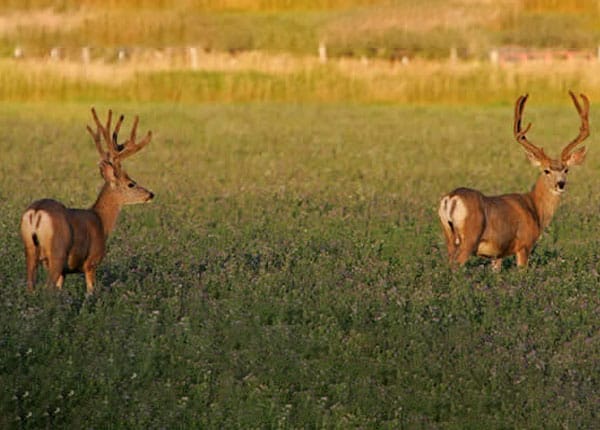
These two bucks were lounging in an alfalfa field in a Unit 53 ranch at about 7,000 feet in elevation in September. These are two nice bucks, but there are bigger ones in the Paonia/Crawford/Hotchkiss area.
Game Management Unit 63 lies south of Highway 92, beginning at the Highway 65 intersection on the west, down to the Black Canyon of the Gunnison River on the south, all the way to where Highway 92 crosses the dam at Blue Mesa Reservoir. My ranch is just west of Crawford in Unit 63, and I spotted a 31-inch-wide mule deer buck wandering around amongst the horses during the hunting season. It’s common to see big bucks and some nice bulls in Unit 63.
Trophy opportunities The game management units in the North Fork Valley region are known for good elk hunting for medium to large bull elk and for excellent hunting for trophy mule deer bucks. Shall we talk numbers? For those of you familiar with the Safari Club International gross scoring system or Boone & Crockett scoring system, mule deer are the real trophy opportunity in the hunting areas surrounding Paonia, Crawford, Hotchkiss, and Cedaredge.
Trophy mule deer bucks Two years ago, an archery hunter took a deer in the wilderness east of Crawford that gross scored over 270. That’s a monster buck! Hunters in the Paonia/Crawford/Hotchkiss area regularly bag bucks scoring in the 180 range, and we know of one outfitter whose clients tagged 10 bucks scoring over 200 this past fall. Just so you’re aware, the Boone & Crockett record book requires a minimum score of 190, and most hunters are thrilled with any buck that scores 170 or better. Even when compared to the entire Western United States, the quality of animals produced in the Paonia/Crawford/Hotchkiss area are as good or better than anywhere in the West. That’s not to say that every hunter is going to bag a monster buck. Trophies are still trophies and hard to get. However, your chances of scoring on a huge buck are better than most other quality regions.
Excellent elk hunting Hunters can certainly bag trophy elk in any of these areas, but it’s uncommon for record-book elk to be taken in the North Fork Valley and surrounding areas. The West Elk Wilderness is a good region for elk hunting, and hunters are usually happy to take a branch-antlered 4×4 or 5×5 bull. Some hunters are fortunate enough to connect on 6×6 and larger bulls, some scoring well above 300 points, and there are more and more bulls that are making it into true trophy status, 350 and larger.
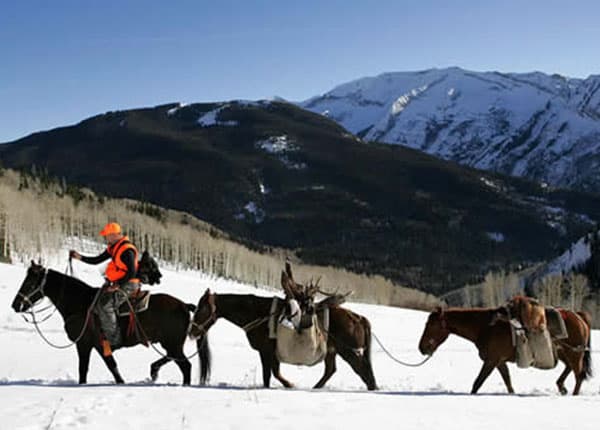
Elk hunting in the mountains surrounding the North Fork Valley can be excellent, but most hunters are happy when they bag a smaller bull like this 4×4.
Hunting properties that produce excellent deer come up for sale on a regular basis. Your parameters for purchasing a hunting property may be entirely different than if you’re seeking a productive cattle ranch or horse property. A good deer hunting ranch may be primarily oak brush and serviceberry with some shaded draws of dark timber. If there’s a creek with running water and an alfalfa hayfield below, that can really draw the deer into the ranch. If there’s access to nearby national forest or BLM land, even better.
Deer often migrate to lower elevations, even on the valley floor, as early as mid-October. Hunting can improve dramatically once the deer begin to migrate. When the rut starts in early to mid-November, hunters lucky enough to have a late-season tag in their pocket can have terrific hunting for big bucks.
Elk typically stay at higher elevations than the deer, though they will drift down to private ranches as the snow gets deeper in the mountains. Usually you won’t see elk on ranches along the river corridors, but occasionally a herd will winter at low elevations.
All the Game Management Units (52, 521, 53, and 63) in the Paonia, Crawford, and Hotchkiss areas offer excellent hunting. Certain ranch properties are more desirable than others, depending on variables such as proximity to national forest or BLM land, proximity to wilderness mountain ranges, water, browse, and migration corridors. If you’re in the market for a Colorado fishing or hunting property, call me, Gary Hubbell, for more information.
As a former wilderness hunting guide, fly-fishing guide, horseman, rancher, outdoor writer, professional photographer, and location scout for photo and film productions, I have more expertise in locating the perfect ranch hunting or fishing property than most brokers will ever have.
Hunting Property Fishing Property North Fork Valley Colorado

